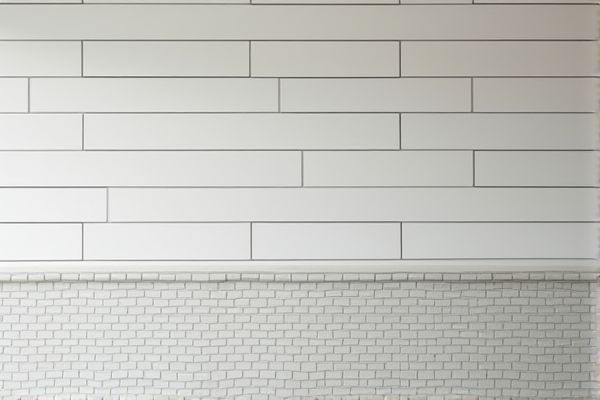
Shiplap walls offer a rustic, warm aesthetic with easy installation and maintenance, while tile walls provide a durable, water-resistant surface ideal for bathrooms and kitchens. Explore the rest of the article to discover which option best suits Your style and practical needs.
Table of Comparison
| Feature | Shiplap Wall | Tile Wall |
|---|---|---|
| Material | Wood or MDF panels | Ceramic, porcelain, or stone tiles |
| Installation | Quick, nails or screws required | Labor-intensive, requires adhesive and grout |
| Durability | Moderate, prone to moisture damage if untreated | High, water-resistant and long-lasting |
| Maintenance | Easy, occasional cleaning and repainting | Low, simple cleaning of grout and tiles |
| Appearance | Rustic, natural wood texture | Variety of styles, textures, and colors |
| Cost | Lower initial cost | Higher initial investment |
| Best Use | Living rooms, bedrooms, accent walls | Kitchens, bathrooms, high-moisture areas |
Introduction to Shiplap Walls vs Tile Walls
Shiplap walls feature overlapping wooden boards that create a rustic, textured appearance popular in farmhouse and coastal designs, while tile walls offer a sleek, durable surface ideal for moisture-prone areas like bathrooms and kitchens. Shiplap's natural wood grain and ease of installation contrast with tile's wide variety of colors, patterns, and water-resistant properties. Choosing between shiplap and tile walls depends on Your desired aesthetic, maintenance preferences, and room functionality.
Aesthetic Differences: Shiplap vs Tile
Shiplap walls offer a rustic, horizontal plank look characterized by visible grooves and a warm, textured appearance that enhances farmhouse or coastal aesthetics. Tile walls provide a sleek, polished finish with a wide range of patterns, colors, and materials like ceramic, porcelain, or natural stone, ideal for modern and elegant designs. The choice between shiplap and tile significantly impacts the room's ambiance, with shiplap emphasizing natural, cozy charm and tile delivering durability and a sophisticated visual appeal.
Material Composition and Durability
Shiplap walls are typically made from wooden planks, offering natural insulation and a rustic aesthetic, while tile walls consist of ceramic, porcelain, or stone, ensuring high resistance to moisture and staining. Wood shiplap requires periodic sealing and maintenance to prevent warping or rot in humid environments, whereas tile walls provide superior durability and ease of cleaning, especially in wet areas like bathrooms and kitchens. The choice between shiplap and tile walls largely depends on the desired style and the wall's exposure to moisture and wear.
Installation Process: Shiplap vs Tile
Shiplap wall installation involves nailing or screwing wooden boards directly onto wall studs or furring strips, making it a quicker and more straightforward process compared to tile installation. Tile wall installation requires proper surface preparation, applying mortar or adhesive, precise tile placement, spacers for grout lines, and grouting, which makes it more labor-intensive and time-consuming. Shiplap is ideal for DIY projects due to its ease of installation, while tile demands professional skills for best results and durability.
Cost Comparison: Which is More Budget-Friendly?
Shiplap walls generally offer a more budget-friendly option compared to tile walls, with material costs ranging from $2 to $6 per square foot, whereas tile can range from $5 to $15 or more per square foot depending on the type and quality. Installation costs for shiplap are typically lower due to easier and faster application, while tile installation requires skilled labor and more time, driving up overall expenses. When considering your budget, shiplap provides an attractive, cost-effective alternative to the often higher-priced and maintenance-intensive tile wall.
Maintenance and Cleaning Requirements
Shiplap walls require minimal maintenance, typically needing regular dusting and occasional wiping with a damp cloth to prevent dirt buildup. Tile walls offer greater durability and are highly resistant to moisture, making them ideal for areas prone to water exposure, but grout lines require periodic cleaning to prevent mold and mildew. Your choice between shiplap and tile walls should consider the ease of upkeep and the environment in which they will be installed.
Suitability for Different Rooms
Shiplap walls offer a warm, rustic aesthetic ideal for living rooms, bedrooms, and hallways due to their wood texture and ease of installation. Tile walls excel in moisture-prone areas like bathrooms and kitchens, providing durability, water resistance, and easy cleaning. Choosing between shiplap and tile depends on the room's functional requirements and desired design style.
Moisture Resistance and Longevity
Shiplap walls, made from wood, are less moisture-resistant and may warp or develop mold in humid environments compared to tile walls, which excel in water resistance due to their non-porous surfaces. Tile walls offer superior longevity, maintaining their structural integrity and appearance over time even in bathrooms or kitchens where moisture exposure is frequent. Choosing tile enhances your space's durability and reduces maintenance concerns related to moisture damage.
Design Versatility and Customization
Shiplap walls offer exceptional design versatility through their horizontal plank layout, providing a rustic yet modern aesthetic that can be painted or stained in various finishes to match diverse interior styles. Tile walls allow extensive customization with an array of materials, colors, patterns, and textures, enabling intricate designs that accommodate both traditional and contemporary looks. Both options provide unique opportunities for personalized design, but tile walls excel in intricate patterning while shiplap emphasizes natural wood character and simplicity.
Final Verdict: Choosing Between Shiplap and Tile Walls
Shiplap walls offer a rustic, textured aesthetic that enhances cozy, farmhouse-style interiors, while tile walls provide durability and moisture resistance, ideal for kitchens and bathrooms. Your choice depends on the specific room's function and design goals: shiplap excels in creating warm, visually dynamic spaces, whereas tile ensures easy maintenance and longevity in wet areas. Evaluate your space's needs carefully to decide whether the charm of shiplap or the practicality of tile aligns best with your home improvement project.
 homyna.com
homyna.com